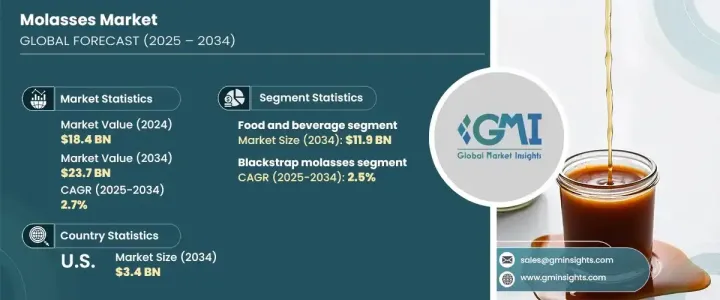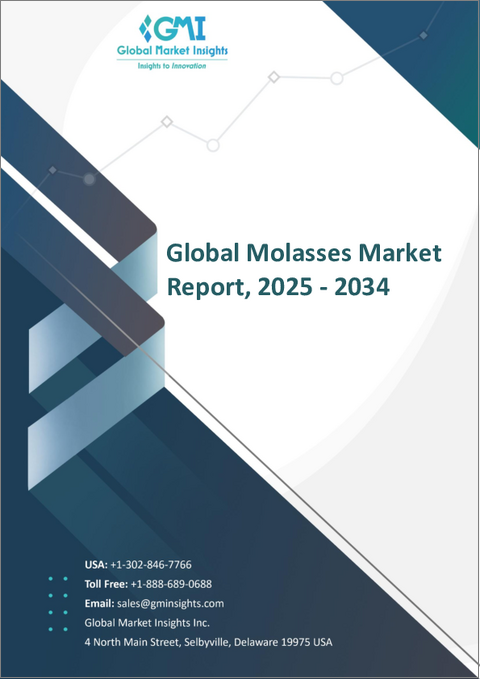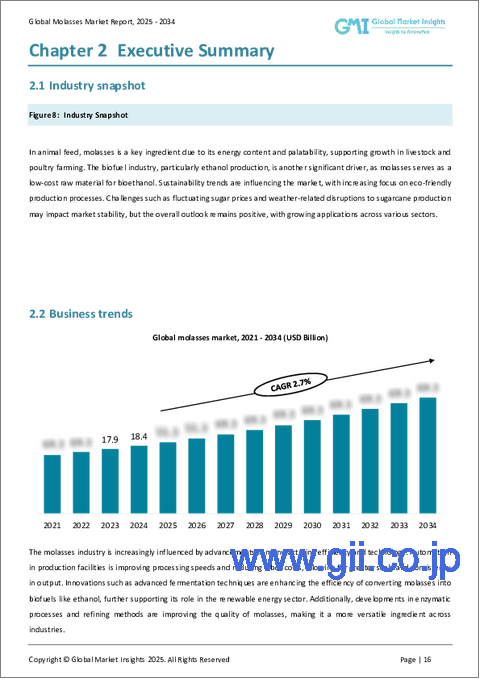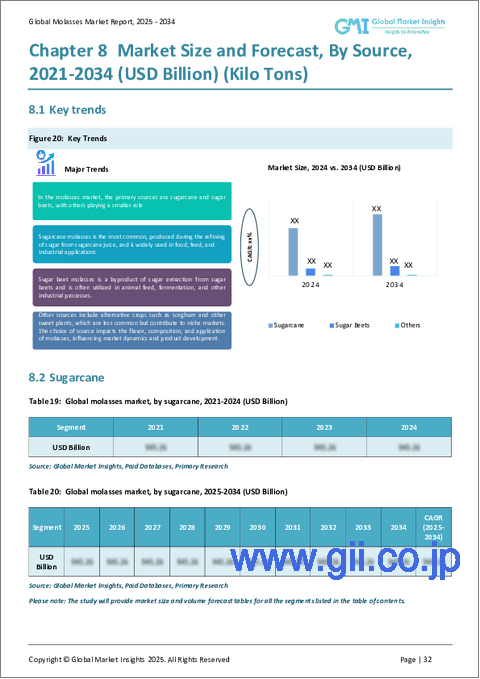|
|
市場調査レポート
商品コード
1684777
糖蜜の市場機会、成長促進要因、産業動向分析、2025年~2034年予測Molasses Market Opportunity, Growth Drivers, Industry Trend Analysis, and Forecast 2025 - 2034 |
||||||
カスタマイズ可能
|
|||||||
| 糖蜜の市場機会、成長促進要因、産業動向分析、2025年~2034年予測 |
|
出版日: 2025年01月08日
発行: Global Market Insights Inc.
ページ情報: 英文 200 Pages
納期: 2~3営業日
|
全表示
- 概要
- 目次
世界の糖蜜市場は2024年に184億米ドルと評価され、食品・飲料、飼料、バイオ燃料生産など主要産業での用途拡大が牽引し、2025年から2034年にかけてCAGR2.7%で成長する見通しです。
天然で加工度の低い原料に対する消費者の需要が高まるなか、糖蜜は食品に好まれる甘味料および風味増強剤として脚光を浴びています。消費者が植物ベースの食生活と天然砂糖の代替品を受け入れているため、焼き菓子、菓子類、飲料での使用が増加しています。より健康的な食習慣やクリーンラベル製品へのシフトは、市場の拡大をさらに加速させています。さらに、バイオ燃料産業、特にエタノール生産の拡大が、費用対効果が高く持続可能な原料としての糖蜜の需要を促進しています。新興市場でも、食生活の動向の変化や加工食品の生産量の増加により、糖蜜の消費量が急増しています。世界のサプライチェーンの力学と地域貿易協定は、今後10年間の市場の軌道を形成する上で重要な役割を果たすと思われます。

糖蜜は高エネルギー含有量を提供し、飼料の嗜好性と消化性を向上させるため、動物栄養学において不可欠な要素であり続けています。食肉と乳製品の世界の需要の増加に伴い、家畜と家禽の飼料における糖蜜の使用量は着実に拡大すると予想されます。飼料効率を改善し、無駄を省くという糖蜜の役割は、動物栄養学にとって不可欠です。さらに、水産飼料やペットフードへの糖蜜の配合が増加していることから、従来の畜産用途にとどまらない糖蜜の多用途性が浮き彫りになっています。また、持続可能な農業や倫理的な畜産へのシフトに伴い、有機および非遺伝子組み換え飼料への糖蜜の需要も増加しています。生産者が飼料の品質を向上させる新たな方法を模索し続ける中、糖蜜はこの分野における重要な原料であり続けると思われます。
| 市場範囲 | |
|---|---|
| 開始年 | 2024年 |
| 予測年 | 2025年~2034年 |
| 開始金額 | 184億米ドル |
| 予測金額 | 237億米ドル |
| CAGR | 2.7% |
ブラックストラップセグメントは2024年に97億米ドルの売上を上げ、2034年までCAGR2.5%で成長すると予測されます。この品種は、その豊富な栄養素と強烈な風味で知られ、食品および動物飼料用途で優位を保ち続けています。カルシウム、鉄、マグネシウムなどのミネラルを多く含むため、健康志向の消費者や家畜栄養士に好まれます。一方、濃い糖蜜や中程度の糖蜜の需要は、そのバランスのとれた甘さと、ソースや飲料から焼き菓子まで幅広い用途への適応性から増加傾向にあります。ブラックストラップ糖蜜よりもマイルドな風味の天然甘味料を求める消費者は、こうした代替品にますます目を向けるようになっており、市場のさらなる多様化を促しています。
食品・飲料部門は2024年に糖蜜市場の64.9%を占め、119億米ドルの売上を計上しました。この分野は植物由来の原料や天然甘味料への嗜好の高まりにより、2025年から2034年にかけてCAGR2.6%で拡大すると予想されます。糖蜜は精製された砂糖に代わる健康的な甘味料として、栄養価が高く加工度の低い食品への需要の高まりに応えています。エナジードリンク、スムージー、機能性飲料、グルメ食品などでの利用は、業界におけるその足跡をさらに広げています。消費者が健康と持続可能性を優先するにつれて、有機糖蜜や非遺伝子組み換え糖蜜の需要が増加し、市場での牙城が強固になると予想されます。
米国の糖蜜市場はCAGR2.3%で成長し、2034年までに34億米ドルに達する見込みです。業界全体、特に食品・飲料セクターで糖蜜の採用が増加していることは、消費者が天然、有機、非遺伝子組み換え原料を好むことを裏付けています。健康志向の買い物客は、クリーンラベルの動向、持続可能性、栄養面での利点に沿った製品に惹かれています。さらに、バイオ燃料分野での糖蜜の利用は、産業界が環境に優しい代替品を求めていることから支持を集めています。食品調達と生産における透明性がますます重視される中、糖蜜は米国市場において消費者の進化する要求に応える定番の原料であり続けています。
目次
第1章 調査手法と調査範囲
- 市場範囲と定義
- 基本推定と計算
- 予測計算
- データソース
- 一次
- 二次
- 有料ソース
- 公的ソース
第2章 エグゼクティブサマリー
第3章 業界洞察
- エコシステム分析
- バリューチェーンに影響を与える要因
- 利益率分析
- 変革
- 将来の展望
- メーカー
- 流通業者
- サプライヤーの状況
- 利益率分析
- 主要ニュース
- 規制状況
- 影響要因
- 業界への影響要因
- 成長促進要因
- 製薬業界の力強い成長指標
- 世界の自動車製造の増加
- ゴム・プラスチック製造業における旺盛な製品需要
- 市場の課題
- 輸送コストの増加
- 成長促進要因
- 規制と市場への影響
- ポーター分析
- PESTEL分析
第4章 競合情勢
- イントロダクション
- 企業市場シェア分析
- 競合のポジショニングマトリックス
- 戦略展望マトリックス
第5章 市場規模・予測:タイプ別、2021年~2034年
- 主要動向
- ブラックストラップ糖蜜
- ダークまたはミディアム糖蜜
- ライト糖蜜
- 粉末糖蜜
- ゴールデンシロップ
- トリークル
第6章 市場規模・予測:用途別、2021年~2034年
- 主要動向
- 食品・飲料
- 動物飼料
- 医薬品・パーソナルケア
- 工業用途
- その他
第7章 市場規模・予測:カテゴリー別、2021年~2034年
- 主要動向
- オーガニック
- コンベンショナル
第8章 市場規模・予測:ソース別、2021年~2034年
- 主要動向
- サトウキビ
- テンサイ
- その他
第9章 市場規模・予測:地域別、2021年~2034年
- 主要動向
- 北米
- 米国
- カナダ
- 欧州
- 英国
- ドイツ
- フランス
- イタリア
- スペイン
- ロシア
- アジア太平洋
- 中国
- インド
- 日本
- 韓国
- オーストラリア
- ラテンアメリカ
- ブラジル
- メキシコ
- 中東・アフリカ
- 南アフリカ
- サウジアラビア
- アラブ首長国連邦
第10章 企業プロファイル
- Amalgamated Sugar
- American Crystal Sugar
- ADM
- Crosby Molasses
- Cargill Incorporated
- International Molasses Corp, Ltd.
- Louis Dreyfus
- Nippon Beet Sugar Manufacturing Co., Ltd.
- Wilmar International
- Bunge Limited
- Spreckels Sugar
The Global Molasses Market, valued at USD 18.4 billion in 2024, is set to grow at a CAGR of 2.7% from 2025 to 2034, driven by expanding applications across key industries, including food and beverage, animal feed, and biofuel production. With rising consumer demand for natural, minimally processed ingredients, molasses is gaining prominence as a preferred sweetener and flavor enhancer in food products. Its use in baked goods, confectionery, and beverages is increasing as consumers embrace plant-based diets and natural sugar alternatives. The shift toward healthier eating habits and clean-label products is further accelerating market expansion. Moreover, the growing biofuel industry, particularly in ethanol production, is propelling the demand for molasses as a cost-effective and sustainable raw material. Emerging markets are also witnessing a surge in molasses consumption due to evolving dietary trends and increased production of processed foods. The global supply chain dynamics and regional trade agreements will play a critical role in shaping the market's trajectory over the next decade.

Molasses remain a vital component in animal nutrition, offering high energy content and enhancing feed palatability and digestibility. With the rising global demand for meat and dairy products, molasses usage in livestock and poultry feed is expected to expand steadily. Its role in improving feed efficiency and reducing wastage makes it indispensable for animal nutrition. Additionally, the increasing incorporation of molasses in aquafeed and pet food formulations highlights its versatility beyond traditional livestock applications. The demand for molasses in organic and non-GMO feed solutions is also on the rise, aligning with the shift toward sustainable farming practices and ethical animal husbandry. As producers continue to explore new ways to enhance feed quality, molasses will remain a key ingredient in this segment.
| Market Scope | |
|---|---|
| Start Year | 2024 |
| Forecast Year | 2025-2034 |
| Start Value | $18.4 Billion |
| Forecast Value | $23.7 Billion |
| CAGR | 2.7% |
The blackstrap segment generated USD 9.7 billion in revenue in 2024 and is projected to grow at a CAGR of 2.5% through 2034. This variety, known for its rich nutrient profile and intense flavor, continues to dominate food and animal feed applications. Its high mineral content, including calcium, iron, and magnesium, makes it a preferred choice for health-conscious consumers and livestock nutritionists. Meanwhile, demand for dark or medium molasses is on the rise due to its balanced sweetness and adaptability in a wide range of applications, from sauces and beverages to baked goods. Consumers seeking natural sweeteners with a milder flavor than blackstrap molasses are increasingly turning to these alternatives, driving further diversification in the market.
The food and beverage sector accounted for 64.9% of the molasses market in 2024, generating USD 11.9 billion in revenue. This segment is expected to expand at a CAGR of 2.6% between 2025 and 2034, driven by the growing preference for plant-based ingredients and natural sweeteners. Molasses continues to serve as a healthier alternative to refined sugars, catering to the increasing demand for nutritious and minimally processed food products. Its usage in energy drinks, smoothies, functional beverages, and gourmet food items is further expanding its footprint in the industry. As consumers prioritize health and sustainability, the demand for organic and non-GMO molasses is expected to rise, reinforcing its stronghold in the market.
The U.S. molasses market is on track to reach USD 3.4 billion by 2034, growing at a CAGR of 2.3%. The increasing adoption of molasses across industries, particularly in the food and beverage sector, underscores consumers' preference for natural, organic, and non-GMO ingredients. Health-conscious shoppers are gravitating toward products that align with clean-label trends, sustainability, and nutritional benefits. Additionally, molasses' application in the biofuel sector is gaining traction as industries seek eco-friendly alternatives. With a growing emphasis on transparency in food sourcing and production, molasses remains a staple ingredient that addresses evolving consumer demands in the U.S. market.
Table of Contents
Chapter 1 Methodology & Scope
- 1.1 Market scope & definition
- 1.2 Base estimates & calculations
- 1.3 Forecast calculation
- 1.4 Data sources
- 1.4.1 Primary
- 1.4.2 Secondary
- 1.4.2.1 Paid sources
- 1.4.2.2 Public sources
Chapter 2 Executive Summary
- 2.1 Industry synopsis, 2021-2034
Chapter 3 Industry Insights
- 3.1 Industry ecosystem analysis
- 3.1.1 Factor affecting the value chain
- 3.1.2 Profit margin analysis
- 3.1.3 Disruptions
- 3.1.4 Future outlook
- 3.1.5 Manufacturers
- 3.1.6 Distributors
- 3.2 Supplier landscape
- 3.3 Profit margin analysis
- 3.4 Key news & initiatives
- 3.5 Regulatory landscape
- 3.6 Impact forces
- 3.7 Industry impact forces
- 3.7.1 Growth drivers
- 3.7.1.1 Strong growth indicators in pharmaceutical industry
- 3.7.1.2 Increasing automobile manufacturing worldwide
- 3.7.1.3 Strong product demand in rubber & plastic manufacturing
- 3.7.2 Market challenges
- 3.7.2.1 Increasing transportation cost
- 3.7.1 Growth drivers
- 3.8 Regulations & market impact
- 3.9 Porter’s analysis
- 3.10 PESTEL analysis
Chapter 4 Competitive Landscape, 2024
- 4.1 Introduction
- 4.2 Company market share analysis
- 4.3 Competitive positioning matrix
- 4.4 Strategic outlook matrix
Chapter 5 Market Size and Forecast, By Type, 2021-2034 (USD Billion) (Kilo Tons)
- 5.1 Key trends
- 5.2 Blackstrap molasses
- 5.3 Dark or medium molasses
- 5.4 Light Molasses
- 5.5 Powdered molasses
- 5.6 Golden syrup
- 5.7 Treacle
Chapter 6 Market Size and Forecast, By Application, 2021-2034 (USD Billion) (Kilo Tons)
- 6.1 Key trends
- 6.2 Food and beverage
- 6.3 Animal feed
- 6.4 Pharmaceuticals and personal care
- 6.5 Industrial applications
- 6.6 Others
Chapter 7 Market Size and Forecast, By Category, 2021-2034 (USD Billion) (Kilo Tons)
- 7.1 Key trends
- 7.2 Organic
- 7.3 Conventional
Chapter 8 Market Size and Forecast, By Source, 2021-2034 (USD Billion) (Kilo Tons)
- 8.1 Key trends
- 8.2 Sugarcane
- 8.3 Sugar Beets
- 8.4 Others
Chapter 9 Market Size and Forecast, By Region, 2021-2034 (USD Billion) (Kilo Tons)
- 9.1 Key trends
- 9.2 North America
- 9.2.1 U.S.
- 9.2.2 Canada
- 9.3 Europe
- 9.3.1 UK
- 9.3.2 Germany
- 9.3.3 France
- 9.3.4 Italy
- 9.3.5 Spain
- 9.3.6 Russia
- 9.4 Asia Pacific
- 9.4.1 China
- 9.4.2 India
- 9.4.3 Japan
- 9.4.4 South Korea
- 9.4.5 Australia
- 9.5 Latin America
- 9.5.1 Brazil
- 9.5.2 Mexico
- 9.6 MEA
- 9.6.1 South Africa
- 9.6.2 Saudi Arabia
- 9.6.3 UAE
Chapter 10 Company Profiles
- 10.1 Amalgamated Sugar
- 10.2 American Crystal Sugar
- 10.3 ADM
- 10.4 Crosby Molasses
- 10.5 Cargill Incorporated
- 10.6 International Molasses Corp, Ltd.
- 10.7 Louis Dreyfus
- 10.8 Nippon Beet Sugar Manufacturing Co., Ltd.
- 10.9 Wilmar International
- 10.10 Bunge Limited
- 10.11 Spreckels Sugar






